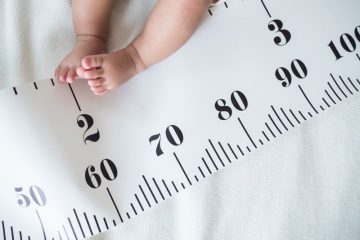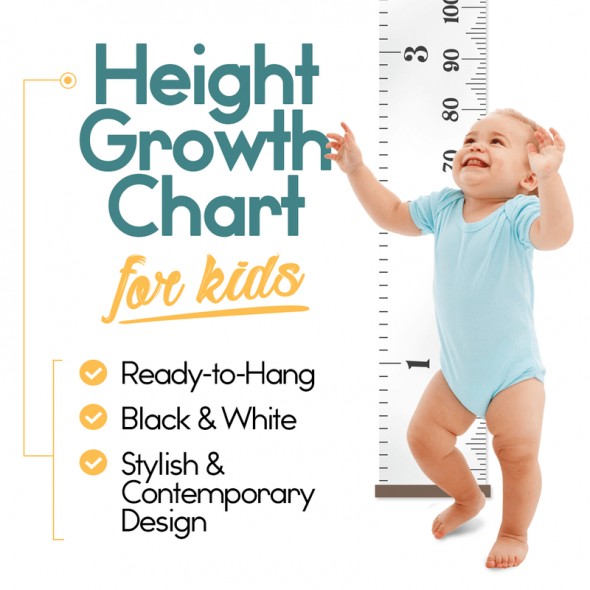
Do you have a height chart at home? If you don’t, you may want to buy one for your child.
A child’s height chart is a great way to measure your child’s growth and track their progress over time. Aside from height, there are other measurements you need to jot down, like weight and head circumference. In this blog post, we will show you how to read your child’s growth using a height chart, plus some quick tips on ensuring that your child grows at a healthy pace.
Measurements to Check Your Child’s Growth Curve
A growth chart helps compare your baby’s growth with other babies of the same gender and age. Of course, babies grow at different rates, but these growth charts provide a rough guide of what is considered “normal.”
If your baby falls outside of the normal range, it does not necessarily mean there is a problem, but it may warrant further checkups with your little one’s pediatrician.
Discover how to read these charts at home using our quick guide.
Head Circumference
Measuring a baby’s head circumference is an important part of their wellness checks. If your baby’s head is unusually big, they might have hydrocephalus. Meanwhile, a small head circumference can indicate microcephaly.
To measure your baby’s head, you’ll need a soft measuring tape. Then:
- Find the spot on your baby’s head that is midway between the eyebrows and the top of the head.
- Wrap your measuring tape around your little one’s head, just above the ears. Make sure the measuring tape is leveled, and that it’s snug but not too tight since your baby’s bones are soft.
- Jot down where the tape ends meet.
Weight
The best way to get an accurate weight measurement is to use a scale designed specifically for babies. But if you don’t have one of those handy devices, there’s still a way to get a pretty good estimate of their weight.
Just weigh yourself on a regular scale, then weigh yourself holding your baby again. The difference between the two numbers is generally close to what your baby weighs on their own. Of course, this method isn’t perfect, but it’s a quick and easy way to get a ballpark figure of your baby’s weight.
Length
Measuring your baby’s length is the third growth indicator of your baby’s development. There are a few different ways to do this at home, but the most accurate method is to use a flat surface, like a floor or a countertop.
First, place your baby on their back on the surface, and then use a measuring tape or kid’s height chart to measure from the top of their head to their feet. Just be sure to place the ruler or tape measure perpendicular to their body so that you’re measuring their full length. Once you have your measurement, record it on your baby’s growth chart.
How to Interpret Your Baby’s Percentile
If you’re a seasoned parent, you’ve probably heard the term “percentile” used to describe your baby’s growth. But what does it mean?
Simply put, a percentile is a way of comparing your baby’s growth to that of other babies their age based on graphs from the World Health Organization and Centers for Disease Control and Prevention. You’ll need to determine which percentile your child falls into based on their age and gender. To do this, simply find their age and gender on the chart and locate their measurements. Once you have their percentile, you can interpret the results.
So, for example, if your little boy is in the 50th percentile for height, that means he falls right at the center of the growth graph—50% of babies his age are taller than he is, and 50% are shorter.
Remember, percentiles are just a guide. Just because your baby is in the top 10% or the bottom 10% doesn’t mean there’s anything wrong. In fact, most babies will move up and down the percentile charts over time.
That said, if you’re worried about your baby’s growth, talk to your pediatrician. They can conduct further tests to see if your little one is healthy.
Tips for a Healthy Growing Baby
Watching your baby grow is one of the most fulfilling experiences parents can have. However, it can also be a time of great worry and anxiety. Being that growth charts and percentiles are just guides, how can you tell that your child is growing at a healthy rate? Here are a few expert tips to ensure that your little one is on track:
- First, make sure that you are providing adequate nutrition. A healthy diet is crucial for growth and development. If you are breastfeeding, make sure to eat healthy and filling meals. If you are formula feeding, ask your pediatrician for the best formula suited to your baby’s needs.
- Second, encourage physical activities with your little one. Babies need time to move and explore to develop strong muscles and bones. So provide plenty of opportunities for tummy time, crawling, and other forms of movement.
- Third, make sure that you are providing adequate stimulation. Your child needs mental stimulation to develop properly. Introduce them to new sounds, textures, and colors. Read aloud to them and engage in lots of back-and-forth conversation.
Monitor Your Child’s Height With Ashtonbee’s Height Growth Chart

It is essential to watch over your baby’s growth to ensure they are developing healthily during their early years.
You can do this by measuring them at home with a height growth chart and comparing their measurements against the percentile curves provided by pediatricians. Other than keeping track, feeding them properly and giving proper care can nurture your child to grow big and strong.
Ashtonbee offers an easy-to-use, accurate height chart that will help you track your baby’s progress every step of the way. Whether your infant can stand or they can hardly crawl, the height chart provides accurate measurements in centimeters, inches, and feet.
Order your height chart today and start monitoring your child’s growth!



